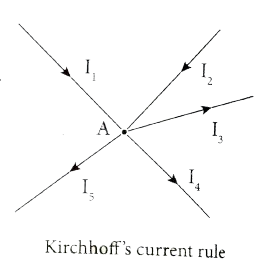State and explain Kirchhoff's rules. Solution in Tamil

Kirchhoff.s first rule (current rule or junction rule):
Statement: It states that the algebraic sum of the currents at any junction of a circuit is zero. It is a statement of conservation of electric charge.
Explanation: All charges that enter a given junction in a circuit must leave that junction since charge cannot build up or disappear at a junction. Current entering the junction is taken as positive and current leaving the junction is taken negative.
Applying this law to the junction A,
I1+I2−I3−I4−I5=0
or I1+I2=I3+I4+I5
Kirchhoff.s second rule (voltage rule or loop rule)
Statement: It states that in a closed circuit the algebraic sum of the products of the current and resistance of each part of the circuit is equal to the total emf included in the circuit. This rule follows from the law of conservation of energy for an isolated system. (The energy supplied by the emf sources is equal to the sum of the energy delivered to all resistors).
Explanation: The product of current and resistance is taken as positive when the direction of the current is followed. Suppose if the direction of current is opposite to the direction of the loop, then product of current and voltage across the resistor is negative. It is shown in Fig. (a) and (b). The emf is considered positive when proceeding from the negative to the positive terminal of the cell. It is shown in Fig. (c ) and (d).


Kirchhoff voltage rule has to be applied only when all currents in the circuit reach a steady state condition (the current in various branches are constant).
Topper's Solved these Questions
- CURRENT ELECTRICITYBOOK - FULL MARKSCHAPTER - CURRENT ELECTRICITYEXERCISE - TEXTBOOK EVALUATION (Numerical Problems)
15 Videos
- CURRENT ELECTRICITYBOOK - FULL MARKSCHAPTER - CURRENT ELECTRICITYEXERCISE - Additional Questions Solved (Choose the correct answer)
41 Videos
- CURRENT ELECTRICITYBOOK - FULL MARKSCHAPTER - CURRENT ELECTRICITYEXERCISE - TEXTBOOK EVALUATION (Short Answer Questions)
21 Videos
- COMMUNICATION SYSTEMSBOOK - FULL MARKSCHAPTER - COMMUNICATION SYSTEMSEXERCISE - ADDITIONAL QUESTIONS (Additional problems)
3 Videos
- DUAL NATURE OF RADIATION AND MATTERBOOK - FULL MARKSCHAPTER - DUAL NATURE OF RADIATION AND MATTEREXERCISE - ADDITIONAL QUESTIONS -( ADDITIONAL NUMERICAL PROBLEMS : )
10 Videos
Similar Questions
The following graphs represent the current versus voltage and voltage versus current for the six conductors A,B,C,D,E and F. Which conductor has least resistance and which has maximum resistance?
View SolutionWhen current I flows through a wire, the drift velocity of the electrons is v. When current 2I flows through another wire of the same material having double the length and area of cross-section, the drift velocity of the electrons will be
View SolutionWhy current is a scalar?
View SolutionA radio can tune into any station in the 7.5 MHz to 12 MHz band. What is the corresponding wavelength band ?
View SolutionIf a light of wavelength 4950 Å is viewed as a continuous flow of photons, what is the energy of each photon in eV ? (Given h=6.6×10−34Js, c =3×108ms−1)
View SolutionState the Kirchhoff's rules used in electric networks. How are these rules justified ?
View Solutionकिरचॉफ के नियमो को लिखिए तथा उसके आधार पर व्हीटस्टोन सेतु का सिद्धांत समझाइए ।
View SolutionState the two Kirchhoff's laws . Explain briefly how these rules are justified .
View SolutionState Kirchhoff's current rule.
View SolutionState and explain Kirchhoff's rules.
View SolutionState the sign convention for applying Kirchhoff's first rule.
View SolutionState the sign convention for applying Kirchhoff's first rule.
View SolutionState Kirchhoff's junction rule.
View SolutionSate Kirchhoff's voltage rule.
View SolutionExplain the Kirchhoff's Junction rule.
OR.
What is Kirchhoff's junction rule?
View Solution
